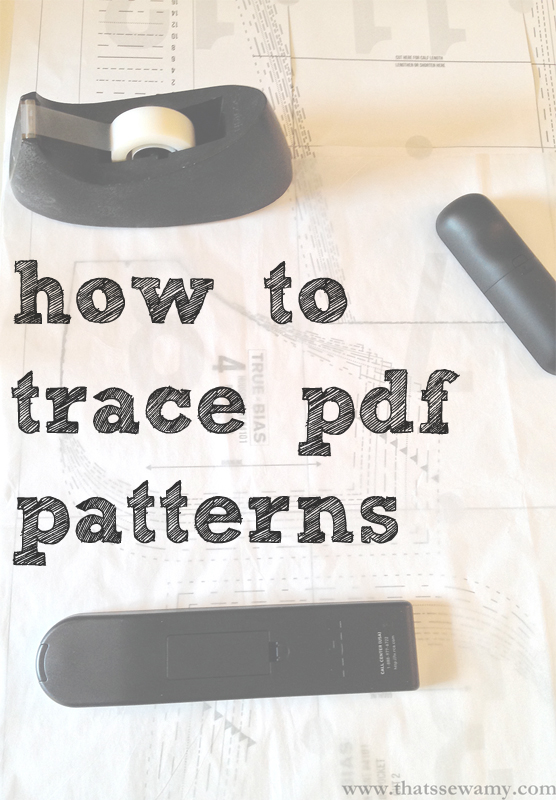

I purchase a lot of pdf patterns online. I know pdf can be a pain but lately I prefer them over regular tissue patterns. Mainly because of sizing. With a regular tissue pattern you choose your size and then cut out your pattern accordingly. The problem is, what if you lose/gain weight? What if this pattern is for a baby/child and they will be growing out of that size tomorrow? I don’t want to have to go buy another pattern.
I choose to trace my pdf patterns instead of cut them out because it makes more sense to me. I don’t like using any of my pins on paper because it dulls them so quickly. Also, I can’t see through the paper pattern to match up prints. Lastly, I don’t want to waste more paper printing out another copy later and waste time taping it together again.
Below is the system I use, hopefully you’ll find it useful too! (the pattern I am tracing is True Bias – Hudson Pant)
#1 – PRINT AND TAPE YOUR PDF PATTERN TOGETHER

If you aren’t familiar with how to print and put together a pdf pattern Tilly and the Buttons has a great tutorial you should check out.
#2 – USE GIFT WRAP TISSUE PAPER

I like to use white gift tissue paper, the kind you usually crinkle up and put into gift bags. I love this stuff, it’s cheap and feels exactly the same as tissue patterns. I’ve heard you can also use freezer paper – but I wouldn’t iron that!
#3 – IRON TISSUE PAPER

Typically (but not always) this type of paper has a slick side – do not iron on that side! I always double check and make sure to iron on the non-slick side of the tissue. Iron on low heat. You can skip this step but I like to do this with my regular tissue patterns too. This helps to make sure you get an accurate pattern, creases and folds can throw off the shape, sizing and markings of your pattern.
#4 – PLACE TISSUE OVER PDF PATTERN

If one piece of tissue doesn’t cover the pattern piece you are tracing, simply tape together 2 (or however many) pieces. (Beware if you iron this later – you can’t iron the tape!). Use weights or random objects to hold the tissue paper in place while you trace. I’ve found remote controls work really well and I seem to have about 100 of them laying around!
#5 – TRACE PATTERN PIECE

I like to use a pencil in case I mess anything up. I always trace my size, the grain line and any markings such as notches. Be sure to have good lighting so you can see the pdf through the tissue. You can always tape the pdf/tissue paper up to a sliding glass door to make a natural light box.
#6 – WRITE PATTERN INFO ON TRACING

I like to use Sharpies on this part. Make sure to write the following:
– Pattern Company
– Pattern Name/Number
– Pattern Piece Name
– Pattern Piece Number
– How many pieces to cut
– Size
– Markings, notches and grain
*If you use a Sharpie, make sure you put a plain piece of paper behind the tissue because the ink will run right through it:

#7 – HOW TO STORE EVERYTHING

I like to use these 9×12 clasp envelopes, you can get them at Office Depot, Staples, Walmart, etc. They are really cheap and store easily.
I make sure to write:
– Pattern Company
– Pattern Name/Number
– The sizes available on the pattern
– Which sizes I’ve already traced
You could easily print out a picture and tape it to the front too.

You can easily fold up your pdf pattern, instructions and tissue paper and place all of them neatly into the envelope.
I know that may seem like a lot of work for a pattern but this has been the best way for me to use, reuse and get as much use out of my pdf patterns as possible.
Thanks for checking out my tutorial and I hope it’s useful to you!
Update:
Terilynn from Hella TL Swimwear suggested using medical paper to trace my patterns. I ended up ordering some from Amazon and I love it. This is my new go-to for tracing, so give it a try!

Great tutorial. I have used tissue paper before. It is cheap and easy. I really like Sewer cloth (landscaping cloth, septic cloth) It is also cheap , $20 for 300 yards or something like that. And it is wider than tissue paper. The cloth can also be sewn so you can do a little bit of fitting.
Thanks! I have never heard of sewer cloth before – I’ll have to check that out and see what that is – thanks for the tip!
Ha! I write this wearing Hudson Pants at the moment. I trace everything and end up putting my patterns in manila envelopes too! I’m learning to live with PDF patterns. I’m used to tracing with Burda and Ottobre, and I love that tracing gives you the opportunity to choose the seam allowances that you want vs. being beholden to pattern’s seam allowances, plus you don’t have to spoil a pattern. I use soil separator cloth from Home Depot. I’ve never tried gift tissue, though it looks nice and sturdy!
great tips! I use the tru grid to trace my patterns, love the grid lines for lining things up and it doesn’t tear like tissue, so it lasts forever! I like the idea of manilla envelopes. usually put mine in gallon zip loc bags…
I just looked that up – that’s a great idea! I may have to try that, thanks!